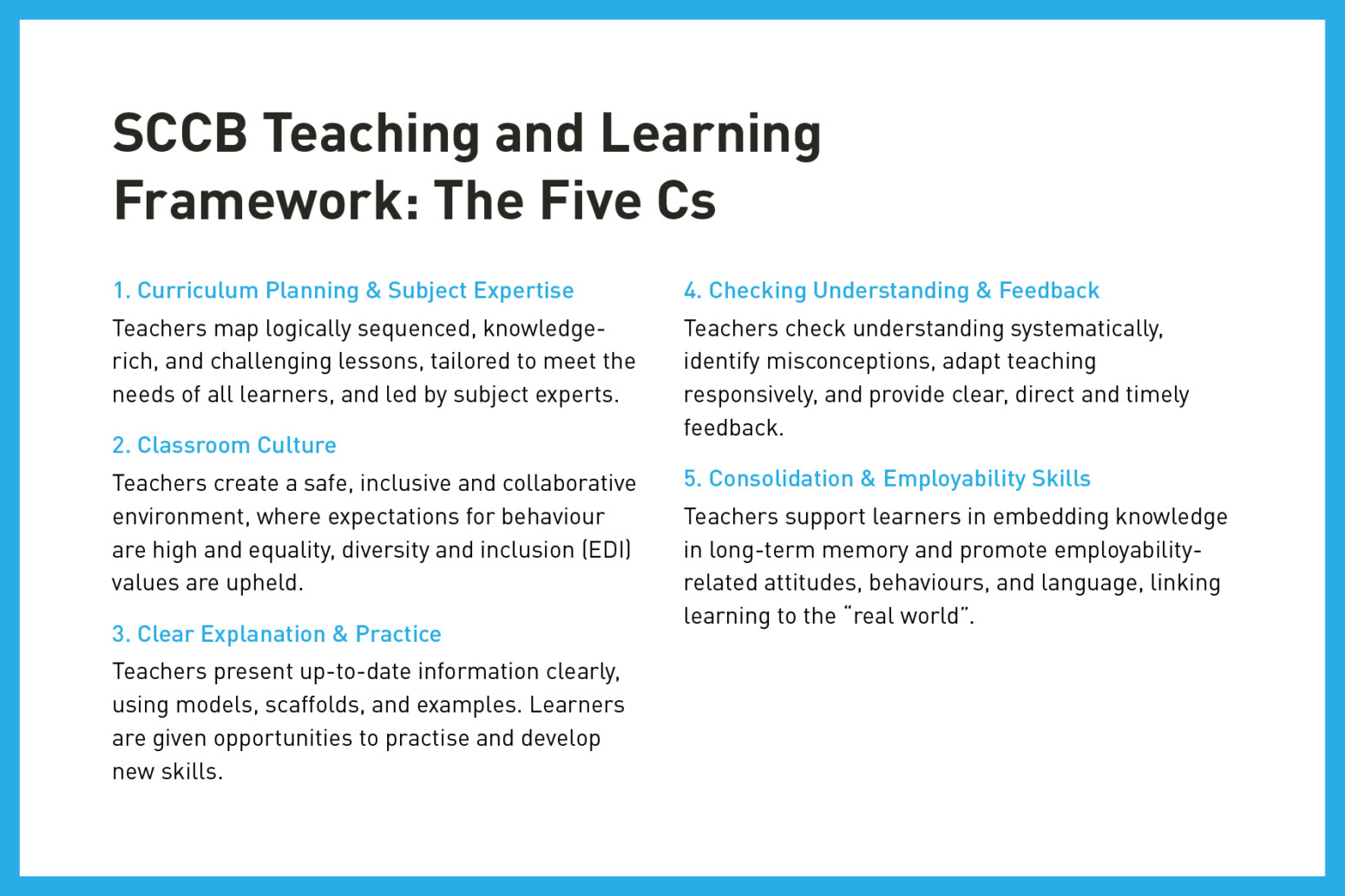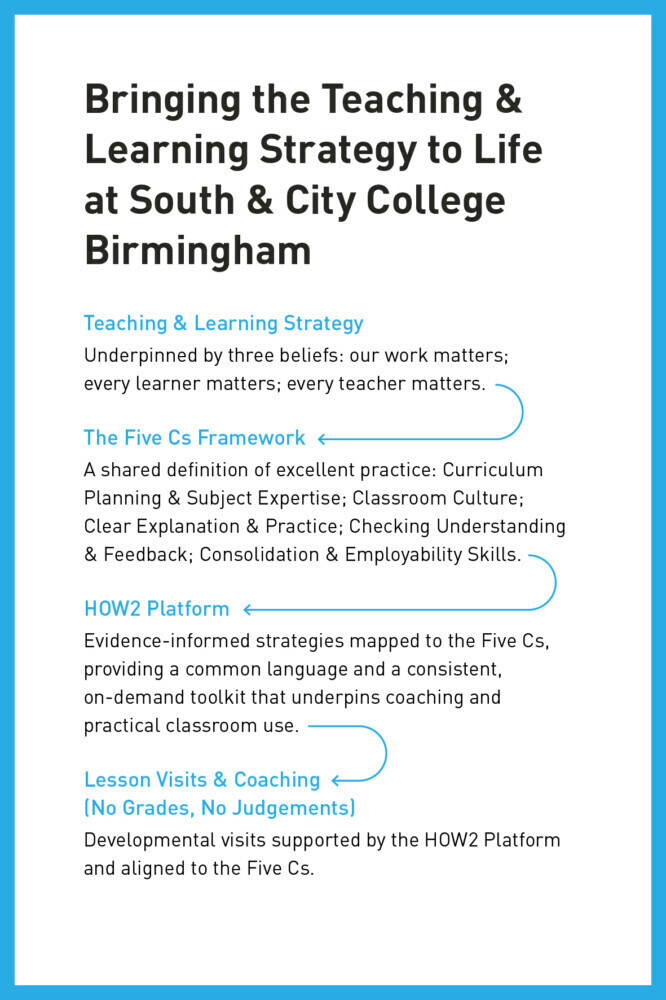The Journey to Teacher-Led Professional Development: HOW2 at South and City College Birmingham
Discover how SCCB is embedding a new teaching & learning framework, developmental lesson visits, and HOW2 to foster teacher-led CPD — building trust, consistency, and professional confidence across eight campuses.

When Ofsted rated South and City College Birmingham (SCCB) as Requires Improvement (RI) in March 2024, the judgement came as no surprise to Vice Principal for Curriculum & Quality, Kam Nandra.
Kam had already been brought in to lead improvement across the college. From the outset, he recognised that while staff were deeply committed, the college lacked a strong culture of developing its teachers and too often relied on external consultants rather than building capacity from within. One of his first steps was to restructure the quality team, creating a new post dedicated to teaching, learning, and innovation.
That role was taken up in December 2023 by Sinead Martin, now Deputy Director of Quality & Teacher Innovation. Reflecting on her early months, Sinead explained: “When I started unpicking things from a teaching and learning perspective, it quickly became clear that we didn’t have a strong, coherent strategy — or enough focus on teacher development and CPD. We didn’t have a shared language to talk about teaching as a professional craft, and we hadn’t defined what great practice looked like across the college.”
The Teaching & Learning Strategy and Framework
Sinead grounded SCCB’s Teaching & Learning Strategy in three core beliefs — our work matters, every learner matters, and every teacher matters — with two aims: to be a beacon of exceptional teaching and learning and to create a life-changing student experience. From this, she set out the Teaching & Learning Framework (TLF), defining five shared components of excellent practice — the Five Cs:
- Curriculum planning and subject expertise
- Classroom culture
- Clear explanation and practice
- Checking for understanding and feedback
- Consolidation and employability skills

Why HOW2 Became the College’s Toolkit for Change
With the framework defined, Sinead began looking for a tool that could bring it to life and embed it across all eight campuses. “The strategy came first, but HOW2 was the tool that helped us operationalise it,” she explained. “I always try to manage both hearts and minds, and HOW2 helped us do that. It gave us a shared language around teaching and learning that had been missing.”
For teachers, the appeal of the HOW2 Platform was the clarity of the techniques, which were visually depicted, dual-coded, step-by-step strategies that they could adapt to their own classrooms. For leaders, it offered consistency and accountability. “I could see who was logging in, how often, and what they were exploring, which is so helpful when you’re trying to measure impact,” said Sinead.
Kam highlighted the benefits of the HOW2 Platform from a leadership perspective: “HOW2 allows people to take control of their own CPD. It makes improvement less subjective because it’s always linked back to a practical technique.”
HOW2 became the college’s go-to toolkit for the professional craft of teaching: teachers gained concrete strategies they could trust, while leaders had a consistent yet adaptable way to support professional learning at scale.
HOW2 allows people to take control of their own CPD. It makes improvement less subjective because it’s always linked back to a practical technique.

Kam Nandra, Vice Principal for Curriculum and Quality
Turning Point: Mapping the Five Cs to HOW2 Sets
One of the strengths of the HOW2 Platform was how easily it could be aligned with SCCB’s new Teaching and Learning Framework. Sinead describes a key realisation: the Five Cs could be matched directly to ‘Sets’ of teaching techniques on the platform. This meant evidence-informed strategies could be mapped to each component of the framework, moving professional dialogue from the abstract to the practical.
For staff, mapping the Five Cs to HOW2 Sets created alignment between the college’s teaching and learning framework and everyday classroom strategies, giving a clear line of sight from strategy to day-to-day teaching.

Leadership View: Building Capacity and Consistency
For Kam, HOW2 was the right fit because it tackled two of SCCB’s toughest challenges: building capacity from within and ensuring consistency across a large, multi-campus college.
“When I got here, I didn’t want to flood the college with consultants. I wanted managers to lead on CPD and own improvement in their curriculum areas. At first, they weren’t confident — they wanted the external gurus back in. But last year, our managers ran a CPD day themselves for 1,500 staff across eight campuses. That was a turning point. HOW2 gave them the tools and resources to feel like professionals, to take responsibility for pedagogy and the science of learning,” Kam explained.
Consistency was the other pressure, raised directly by Ofsted in 2024. “They asked me, how do you ensure consistency across eight campuses and 500 teachers? Before, I couldn’t answer that. Now I can point to HOW2. It gives us a shared language — managers and teachers discuss the same techniques, rather than relying on old war stories. That’s how you start to build a culture of learning,” he added.
Developmental Lesson Visits
As part of the new Teaching and Learning Framework, SCCB introduced a developmental lesson-visit model to open up professional conversations about teaching. When Sinead first arrived, there was no observation process in place. “People would ask me what teaching and learning was like at SCCB and I would say, ‘I don’t know — I haven’t been able to get into classrooms.’
The new approach was deliberately non-traditional: no grades, no judgements, and entirely focused on development. Licensed reviewers were trained in the Five Cs and in using HOW2 as the main tool for feedback. Coaching drew on Jim Knight’s Impact Cycle — identify, learn, apply — so that each visit focused on one clear improvement to work on next.
By linking feedback directly to the framework and to practical HOW2 techniques, lesson visits became the first step in making the strategy real in classrooms. They set the tone for a culture of growth and trust, where teachers could engage honestly and constructively with their own development. They also provided the launchpad for introducing the HOW2 Platform in practice.
HOW2 in Practice
Each review was linked directly to a HOW2 technique. Instead of leaving with broad or abstract targets, staff walked away with a clear, practical next step they could try straight away.
As Ian Skelcher, then a Teaching and Learning Coach, explained: “Post-review, we’d agree a technique from the HOW2 Platform, use the Nudge feature to remind staff about it, and ask them to respond — had they tried it, had it worked, or did they want to try something else more suited to their style?” This key feature of the platform kept coaching conversations continuous, ensuring progress stayed on track while leaving teachers with full autonomy.
Alongside the visits, Ian introduced the Barriers to Progress tool, which helps staff identify classroom challenges and link them to teaching techniques. At SCCB it provided leaders with an anonymous view of what staff felt was holding back progress. In one department, seven out of nine experienced lecturers highlighted the same issues — independent working and low-level disruption. That collective feedback sparked renewed interest in CPD as staff realised they were facing the same challenges, but had never really discussed them together.
Champions — classroom lecturers rather than managers — also played a central role in modelling strategies, sharing successes, and signposting colleagues to the platform. Their authenticity helped colleagues see HOW2 as a peer-led, practical tool rather than a top-down initiative.
Ian created a suite of resources to keep HOW2 visible — including posters, QR-code notepads, and other printed materials linking directly to techniques on the platform. These resources are now being rolled out across staff rooms and CPD sessions, serving as everyday prompts and giving the college’s teaching and learning culture a strong visual identity.
HOW2 was also built into induction. New and part-time staff, including those joining from industry, were introduced to the platform from day one. This gave them immediate access to proven, visual strategies and helped standardise practice across sites. Leaders valued the usage data, which highlighted which strategies were being used and where additional support might be needed. That visibility also set the stage for early signs of improvement.
Post-review, we’d agree a technique from the HOW2 Platform, use the Nudge feature to remind staff about it, and ask them to respond — had they tried it, had it worked, or did they want to try something else more suited to their style?

Ian Skelcher, Deputy Head of School: Digital & Computing Studies
Signs of Improvement
SCCB is already seeing encouraging signals from both external scrutiny and internal feedback.
Staff engagement with CPD. On a recent CPD day, 84% of staff said the sessions were useful and planned to implement the highlighted HOW2 techniques. The day had been informed by themes emerging from lesson visits, with strategies highlighted through the HOW2 Platform.
External validation. In the Ofsted monitoring visit on 26 – 27 March 2025, inspectors noted that leaders had introduced a clear teaching and learning framework which underpinned a thorough assessment of the quality of teaching and informed extensive training to develop teachers’ craft of teaching. They also recorded that most subject areas have increased the proportion of learners who achieve their qualifications, and that processes to standardise the use of learners’ starting points and target-setting were showing reasonable progress. Kam Nandra points out that these improvements are directly linked to SCCB’s approach of aligning developmental reviews with the Five Cs and then using the HOW2 Platform to provide teachers with practical strategies. In his words, the framework set the direction — but HOW2 was the tool that made it work in classrooms.
Performance trend and consistency. Kam Nandra also highlights SCCB’s 15% improvement in achievement rates over three years, with HOW2 in place for more than half of that period, and points to a marked rise in regional standing — from the lowest performing college in the West Midlands to fourth. He credits the Teaching & Learning Framework and developmental lesson visits, enabled by the HOW2 Platform, as the consistent, college-wide mechanism that allows managers to identify specific skill gaps and support teachers with practical strategies.
What’s Next
SCCB will continue its cycle of developmental lesson visits and use the platform’s Nudge feature to keep momentum alive between conversations. Leaders are set to expand the use of the platform’s Barriers to Progress tool to target CPD where staff indicate support is needed, while Champions, induction, and newly created visibility resources will keep these techniques front-of-mind across campuses.
Ian has also been trialling the platform’s integrated AI Assistant in some of the toughest vocational areas, with excellent feedback so far. The Assistant provides real-time, context-specific coaching that helps staff adapt evidence-based strategies to their own subject, lesson focus, and teaching environment. Building on these results, the team plans to expand its use so that even the most specialised disciplines can access practical, tailored support — grounded in proven teaching methods.
SCCB’s improvement journey is firmly underway: the Five Cs and the HOW2 Platform remain the foundation for teaching and learning — keeping improvement focused, consistent, and practical across classrooms.
-
To learn more about the HOW2 Platform, follow TeachingHOW2s on LinkedIn for updates and insights.






